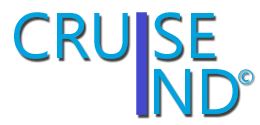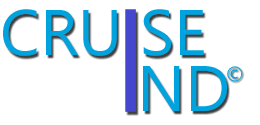
Royal Caribbean International announced their first Quarter results and they were pretty positive even though price for fuel has been steadily increasing.
Highlights
See the full presser after the break:
Royal Caribbean Cruises Ltd. today announced better than expected first quarter results and updated guidance for the remainder of 2011.
Key Highlights
For the First Quarter 2011:
Net income was $91.6 million, or $0.42 per share versus, $87.4 million, or $0.40 per share in 2010. Included in the 2010 results was a one-time gain of $85.6 million, or $0.39 per share related to a legal settlement.
Net Yields increased 4.0% (2.8% on a Constant-Currency basis);
Net Cruise Costs per APCD (“NCC”) were up 0.2% (down 0.1% on a Constant-Currency basis);
Included in Other Income/(Expense) was an $0.11 per share marked-to-market gain on the company’s fuel option portfolio.
2011 Guidance:
The company has been able to largely offset higher fuel prices through its hedging strategies as well as the impact of currency exchange rates. The effects of recent geopolitical events in Northern Africa and Japan have also been partially offset by improvements in the company’s other itineraries. As a result, full year EPS guidance has been reduced by $0.15 per share to a range of $3.10 to $3.30.
“The year started off with a roar — strong bookings, low costs and solid profits — and in the first quarter every one of our brands exceeded its forecast,” said Richard D. Fain, chairman and chief executive officer. Fain added, “Unfortunately, the events in Northern Africa and Japan have turned what was shaping up as a spectacular year into merely a very good one. Nonetheless, other than adjustments for fuel pricing, our earnings guidance for the year is essentially intact despite these dramatic geopolitical events. The demand for the majority of our products has remained quite strong and even the impacted itineraries have begun to improve.”
First Quarter 2011 Results
Royal Caribbean Cruises Ltd. today announced net income for the first quarter 2011 of $91.6 million, or $0.42 per share. This compares to net income of $87.4 million, or $0.40 per share, in the first quarter of 2010, which included a gain on a legal settlement of $85.6 million, or $0.39 per share. An $0.11 per share marked-to-market gain on the company’s fuel option portfolio is included in first quarter 2011 results.
Revenues improved to $1.7 billion in the first quarter of 2011 compared to $1.5 billion in the first quarter of 2010 as a result of capacity increases and yield improvements. Net Yields for the first quarter of 2011 increased 4.0% (2.8% on a Constant-Currency basis). The company saw improvement in both ticket and onboard revenue yields and across all major product groups.
Costs in the first quarter of 2011 were well controlled with most expense categories performing better than expected. While a less significant factor, some timing shifts to later in 2011 occurred. NCC were up 0.2%, and NCC excluding fuel increased 0.8%. Excluding currency impacts, the comparable figures show decreases of 0.1% and increases of 0.6%, respectively.
At-the-pump fuel pricing (including the benefit of the company’s hedging program) was very similar to earlier calculations at $511 per metric ton. As previously disclosed, in addition to its fuel hedging activities the company has purchased various fuel options as further protection against rising fuel prices. Unlike its fuel swaps which largely receive hedge accounting treatment, fuel options are marked-to-market to the income statement at the end of each reporting period. During the first quarter of 2011 the value of the company’s fuel option portfolio increased by $24.2 million, or $0.11 per share, and the associated gain was booked to Other Income/(Expense).
2011 Outlook
The company provided the following updates to its forward guidance:
Revenue:
For the full year, the company expects Net Yields to improve 5% to 7% on an as-reported basis and 3% to 5% on a Constant-Currency basis. For the second quarter, the company expects Net Yields to improve approximately 5% on an as-reported basis and between 1% and 2% on a Constant-Currency basis.
As compared to prior guidance, three significant factors have influenced the company’s outlook on yields: geopolitical events, the weakening of the U.S. Dollar and increased tour activities.
Geopolitical: Bookings at the beginning of the year in the Mediterranean and in Asia were quite strong. However, events in Northern Africa led to itinerary modifications of 63 sailings and the tragic series of calamities in Japan led to itinerary modifications of 21 sailings. The combination of these events is expected to have a direct negative impact on the company’s yields of approximately 1% for the full year.
Weakening of the U.S. Dollar: The company’s revenues are favorably influenced when the U.S. Dollar weakens versus other currencies. Assuming current currency exchange rates, the company expects Net Yields for the full year on an as-reported basis to improve between 1% and 2% from its previous guidance as a result of currency.
Increased tour activity: The company’s Spanish brand, Pullmantur, operates a tour company that includes revenue from land tours, air charter and travel distribution. Recently, Pullmantur has improved its aircraft utilization, and expanded its tour operations and cruise distribution activities in Spain. This combination is expected to improve Net Yields for the full year by approximately 1%.
The yield accretion associated with currency exchange rates and increased tour activities will provide more benefit to the company in the third and fourth quarters. Conversely, the most significant geopolitical yield pressures are expected to occur in the second quarter.
The company also noted that it observed a broad slowdown in bookings for Mediterranean sailings following the unrest in Northern Africa. These booking volumes have now returned to normal levels as a result of reduced pricing. The effect of this booking disruption has been largely offset by the company’s other product groups, including Caribbean and Alaskan itineraries, which continue to show better than expected year-over-year improvement.
Net Cruise Costs (Excluding Fuel):
For the full year, the company expects NCC excluding fuel to increase 4% to 5% on an as-reported basis and 2% – 3% on a Constant-Currency basis. For the second quarter, the company expects NCC excluding fuel to increase between 4% – 5% on an as-reported basis and approximately 2% on a Constant-Currency basis.
Two of the factors influencing the company’s yield outlook, currency exchange rates and increased tour activities, are also affecting NCC guidance.
Weakening of the U.S. Dollar: While the weakening of the U.S. Dollar has a favorable impact on revenues, it has the opposite impact on costs. Assuming current currency exchange rates, the company expects 2011 NCC excluding fuel on an as-reported basis to increase approximately 1% for the full year from the previous guidance as a result of currency
Increased tour activity: The expansion of tour operations within the company’s Pullmantur brand is expected to increase the company’s NCC excluding fuel between 1% and 2% for the full year. The expanded tour activities are not expected to have a material impact on 2011’s profitability.
The company is experiencing some inflationary cost pressures related to food and transportation but this pressure has been offset through savings initiatives in other areas.
These offsets have been obtained without reducing the strategic marketing, web and consumer engagement investments that the company announced at the beginning of the year.
Fuel Expense
The company does not forecast fuel prices and its cost calculations are based on current at-the-pump prices net of hedging impacts. Based on today’s fuel prices the company has included $189 million and $770 million of fuel expense in its second quarter 2011 and full year 2011 guidance, respectively.
Forecasted consumption is now 56% hedged for the remainder of 2011 at a WTI barrel equivalent rate of approximately $75 bbl, 55% hedged in 2012 at a rate of $86 bbl, 40% hedged in 2013 at a rate of $91 bbl and 10% hedged in 2014 at a rate of $103 bbl. Additionally, the company also utilizes fuel options to further protect against escalating fuel prices. WTI Fuel options at strike prices ranging from $90 bbl to $150 bbl cover an additional 44%, 25%, and 11% of estimated consumption in 2011, 2012 and 2013, respectively.

